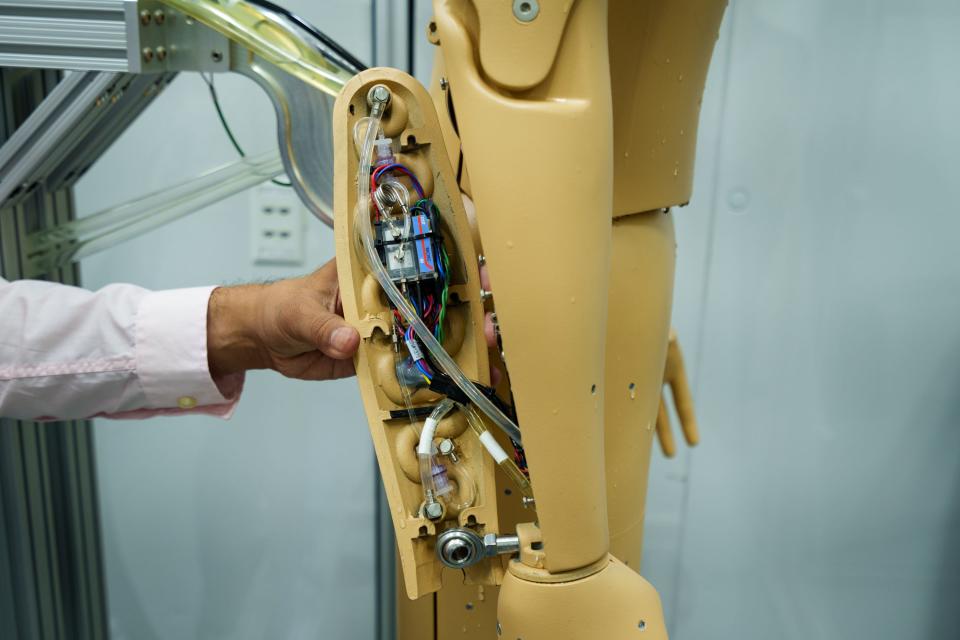ANDI the manikin can take the heat. ASU hopes it can also help people weather hotter days
Arizona State University researchers will put a walking, breathing, sweating dummy through its paces in the lab and around the Tempe campus this summer and in coming years, seeking answers about how to keep people safe in hot environments.
The apparatus is intended to help specify the range of conditions and activities during hot weather that can kill people with various physical attributes or conditions, knowledge that gains importance as cities bake hotter under the twin strains of climate change and concrete urban heat islands.
A company called Thermetics custom built this thermal manikin, known as ANDI, for ASU, with funding from the National Science Foundation's Leading Engineering for America’s Prosperity, Health and Infrastructure (LEAP HI) program. Similar manikins are in use elsewhere, such as performance athletic clothing companies testing the effects of garments on the body, but this is the first with an internal cooling system that allows it to be used outdoors and not only in a controlled heat lab.
Placed in the sun, the manikin can sweat in amounts representing a particular body type or age in response to the heat that a network of sensors detects. If researchers cover the manikin in a fabric created for the purpose, that moisture will wick and cover body surfaces and evaporate, cooling similarly to how a person’s sweat works.
Not all people sweat alike — older people sweat less, for instance — so the device can be programmed to determine how much it would take to push different people to the point of heat stroke and death. The device also breathes via a trailing tank, simulating how the exchange of hot air and moisture affects the body.
“You don’t want to run a lot of these (tests) with a real person,” said mechanical engineering professor Konrad Rykaczewski, the project’s principal investigator. “It’s unethical and would be dangerous.”
Help in the heat: 'Life and death infrastructure': Volunteers plant trees for a new Phoenix 'cool corridor'
ANDI will test what's too hot for which people
This new device will roll along campus sidewalks along with MaRTy, a portable weather station the university's heat researchers have used for several years to measure radiant temperatures reaching pedestrians from the sun or surfaces like pavement heat.

Besides sensing and responding to the incoming heat, ANDI also generates its own heat based on its movements and the modeled functions of internal organs. A metal rod suspends the manikin from a four-wheeled cart, and cables attached to its heels and elbows move it like a marionette as it rolls along, walking on air. The motion sends data to a computerized nerve center in an air-conditioned trailing cart, which determines how much internal heat the simulated workout would generate.
The device can generate heat ranging from roughly what an incandescent light bulb generates to what a hot toaster oven generates, about the difference between person at rest and one running a marathon. Combined with heat from the sun, the sidewalk and the air, it will show what combination is likely to be too much for specific types of people. Then the researchers can run it through the same conditions again but see what changes when they tweak the manikin’s behavior.
“Maybe you should have spent that extra 15 minutes in the shade,” Rykaczewski said, and so the manikin will try that and record the resulting data. “Maybe we should spray water on you for 20 minutes. Maybe it’s a certain clothing.”
Warming Arizona: Phoenix is not prepared for a simultaneous heat wave and blackout, new research shows
Looking for answers about heat-related deaths
There may be numerous applications that different ASU departments ultimately try, but key among the initial work is to test how different body types respond to real-world heat and adjust safety recommendations accordingly.
“The idea is to look at anything that would help us if we have to be outside or want to enjoy being outside,” Rykaczewski said.
Existing guidelines for heat exposure generally track data collected decades ago from military trainees in the Southeast, he said. That means they apply to young, healthy people exerting themselves in a humid environment. They also are geared toward “average” people.
“We’re definitely not all average, by definition,” he said.
Researchers will develop a chart establishing how different conditions affect people of different shapes and masses. Eventually they’ll also model how different afflictions, such as diabetes or schizophrenia, influence body heat reactions.
These details already are needed for the hot world Arizonans live in. Maricopa County’s preliminary report of last year’s heat-related deaths, compiled this spring, counts 425. That’s an all-time high. And county officials have already confirmed four heat-related deaths this year. Most such deaths occur outdoors, and the report notes an uptick in people experiencing homelessness. But why some people die and others don’t often remains a mystery.
“There are situations we know of in the Valley where people are dying of heat and we still don’t fully understand what happened,” co-investigator Jennifer Vanos, an associate professor of sustainability, said in a statement provided by the university. “ANDI can help us figure that out.”
The utility of such information will only grow as the planet and its cities heat up, according to Rykaczewski.
“Going out here in peak heat (today) might be the average day in 20 years,” he said.
Brandon Loomis covers environmental and climate issues for The Arizona Republic and azcentral.com. Reach him at [email protected] or follow on Twitter @brandonloomis.
Environmental coverage on azcentral.com and in The Arizona Republic is supported by a grant from the Nina Mason Pulliam Charitable Trust. Follow The Republic environmental reporting team at environment.azcentral.com and @azcenvironment on Facebook, Twitter and Instagram.
You can support environmental journalism in Arizona by subscribing to azcentral.com today.
This article originally appeared on Arizona Republic: ASU has a new human-shaped device for testing heat effects on body
